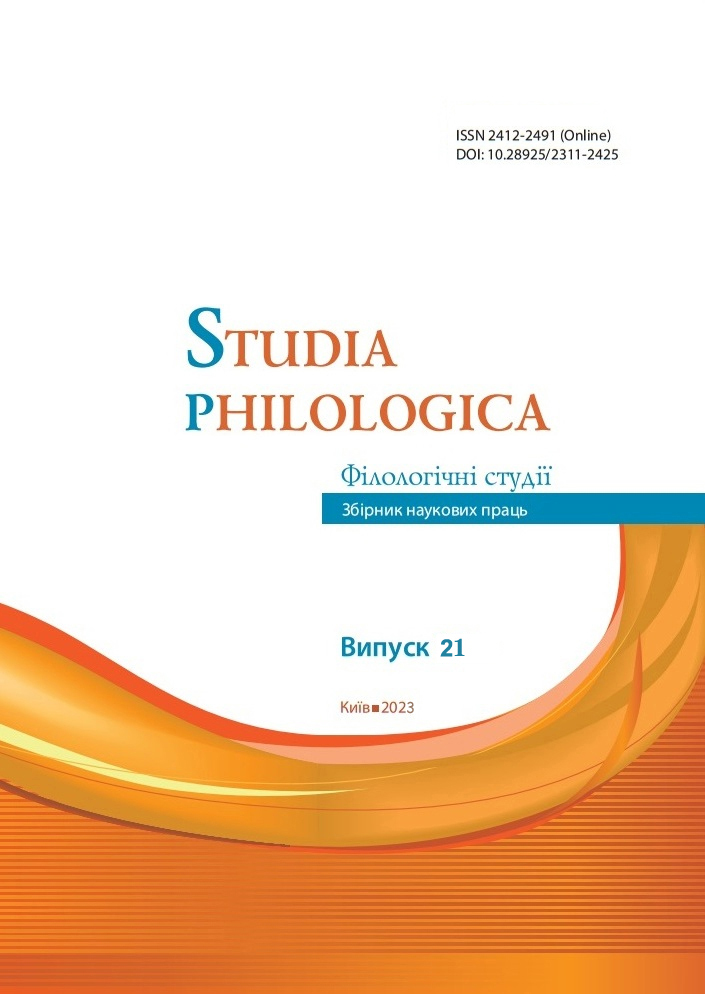Jötnar as “supernatural beings”: a cognitive matrix of the Old Norse verbal representations
DOI:
https://doi.org/10.28925/2311-2425.2023.215Keywords:
myth, Jotun, system, semantic feature, categorization, worldview, mythic spaceAbstract
This article addresses verbal representations of the mythic concept JÖTUNN (Engl. JOTUN) in Old Norse eddic texts. Jötnar as supernatural beings inherent to the Nordic mythic space are regarded as a class of open systems marked by a set of hypertrophied features. Etymological analysis of the concep’s names followed by broader analogue speculations allows identifying the basic “nano-myths” or “code-ons” that iconically outline the JOTUN-system’s “preset” trajectories of behavior and interaction with other systems. The paper focuses on linguo-cognitive premises of language units verbalizing the said concept. Primary attention is paid to identifying sets of JOTUN’s conceptualized features. The article suggests cognitive models and respective frame-like structures. The paper discusses different types of logical and semantic connections betweenthe said conceptual features and models. Our research employs a broad universalia-oriented interdisciplinary approach (M-logic) that focuses on the idea of irrational rationalization of reality (world-building) and encompasses the theory of myth-oriented semiosis. The identified semantic features and cognitive models are thus integrated into a model of a hierarchic plane of an open system therefore creating a “cognitive matrix” of the JOTUN concept. The correlations between the sets of conceptualized features are discussed in terms of their complementary, determinative and causative correlations. The paper argues that the Jötnar appeared as an imbalanced (chaotic) system capable of fractal expansion. The paper highlights the systemic premises of a paradox-type symbiosis between Jötnar and the Aesir.
Downloads
References
Birgisson, B. (2010). The Old Norse Kenning as a Mnemonic Figure. The Making of Memory in the Middle Ages. Ed. Lucie Doležalová. Leiden and Boston: Brill, 199–213.
Birgisson, B. (2012). Skaldic Blends Out of Joint. Blending Theory and Aesthetic Conventions. Metaphor and Symbol, 27 (4), 283–298.
Casteel A. B. (2020). Cognizing as the Wind and Metaphors of Mind: A Reconsideration of Old Norse hugr and Huginn. Oslo: University of Oslo.
Etymological Dictionary of Modern English. Ed. D. Harper. Retrieved September 1, 2023, from http://www.etymonline.com.
(Grimn) Grímnismál. Retrieved September 1, 2023, from https://www.voluspa.org/grimnismal.htm.
(Gylf) Snorra Edda Gylfaginning. Retrieved September 1, 2023, from https://norroen.info/src/snorra/gj/2.html.
Haley-Halinski K. A. (2017). Kennings in Mind and Memory: Cognitive Poetics and Skaldic Verse. Oslo: University of Oslo.
(Harb) Hárbarðsljóð. Retrieved September 1, 2023, from https://www.voluspa.org/harbardsljod.htm
(Hav) Hávamál. Retrieved September 1, 2023, from - https://www.voluspa.org/havamal.htm
(Hym) Hymiskviða. Retrieved September 1, 2023, from https://www.voluspa.org/hymiskvida.htm
(Hyndl) Hyndluljóð. Retrieved September 1, 2023, from https://norroen.info/src/edda/hyndlu/on.html
Kolesnyk, O., (2011), Mifolohichnyi prostir kriz pryzmu movy ta kultury [Mythic space in the scope of language and culture], Chernihiv: ChNPU
Kolesnyk O.S. (2015a). Kontsept-mifolohema ELF u dzerkali movy [Mythic Concept Elf in the Mirror of Language]. Teoretychna i dydaktychna filolohiya, 20, 207-221.
Kolesnyk O.S. (2015b). Kontsept-mifolohema HNOM u dzerkali movy [Mythic Concept DWARF in the Mirror of Language]. Studia Philologica, 3, 23-30.
Kolesnyk O.S. (2016a). Linhvokulturni j linhvoseiotychni osoblyvosti verbalizatsiyi konceptu-mifolohemy DRAKON [Linguo-cultural and linguo-semiotic peculiarities of designating the mythic concept DRAGON]. Odeskyi Linhvistychnyi Visnyk, 7, 225 - 230.
Kolesnyk O. S. (2016 b). Mova ta mif u vymiri mizhdystsyplinarnyh studiy [Language and Myth: an Interdisciplinary Study]. Chernihiv: Desna Polygraph.
Kolesnyk, O., (2019), Cognitive premises of the myth-oriented semiosis. Cognitive Studies | Études cognitive, #19, Article 196, https://ispan.waw.pl/journals/index.php/cs-ec/article/view/cs.1916
Kroonen G., (2013), Etymological Dictionary of Proto-Germanic, Ed. by A. Lubotsky, Leiden-Boston: Brill
Lakoff G., Johnson M. (1990). Metaphors We Live By. Chicago and London: The University of Chicago Press.
Levitskiy, V. (2010). Etimologichekiy slovar germanskih yazykov [Etymological dictionary of Germanic languages]. Vinnytsia: Nova Knyha.
Lindow, J. (2002). Norse Mythology: A Guide to Gods, Heroes, Rituals, and Beliefs. Oxford University Press
(Lok) Lokasenna. Retrieved September 1, 2023, from https://www.voluspa.org/lokasenna.htm
Mikolić, P. (2013). The God-semantic Field in Old Norse Prose and Poetry A Cognitive Philological Analysis. Oslo: Universitetet i Oslo
Nygaard, S., Tirosh, Y. (2021). Old Norse Studies and Collective Memory: An Introduction. Scandinavian-Canadian Studies / Études scandinaves au Canada, 28
Steen, G. Metonymy Goes Cognitive-Linguistic. Style, 39 (1), 1-11.
Pokorny, J. (1959). Indogermanisches etymologisches Worterbuch. Bern : Francke.
(Skald) Snorra Edda: Skáldskaparmál. Retrieved September 1, 2023, from https://norroen.info/src/snorra/gj/3.html
Talmy, L. (1988). Force Dynamics in Language and Cognition. Cognitive Science. 12 (1), 1-138.
(Thry) Þrymskviða. Retrieved September 1, 2023, from https://www.voluspa.org/thrymskvida.htm
(Vaf) Vafþrúðnismál. Retrieved September 1, 2023, from https://www.voluspa.org/vafthrudnismal.htm
(Vol) Völuspá. Retrieved September 1, 2023, from https://www.voluspa.org/voluspa.htm
Vries de, J. (1962). Altnordisches etymologisches Wörterbuch. Leiden: Brill.

Published
How to Cite
Issue
Section
License
Copyright (c) 2023 CC BY 4.0 DEED Attribution 4.0 International

This work is licensed under a Creative Commons Attribution 4.0 International License.

